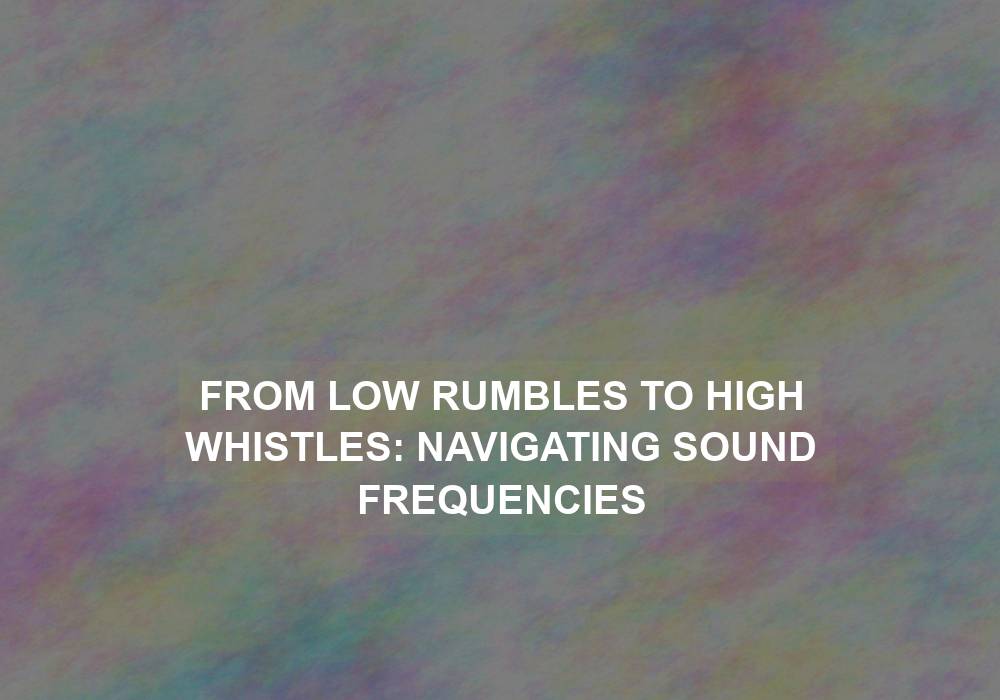Sound frequencies play a significant role in our daily lives, impacting the way we perceive and experience the world around us. From the low rumbles of thunderstorms to the high-pitched whistles of birds, sound frequencies encompass a wide spectrum that captivates our senses. In this article, we will explore the fascinating world of sound frequencies, how they are measured, and their applications in various fields.
Understanding Sound Frequencies
Sound is a form of energy that travels in waves through a medium, such as air, water, or solids. These waves create vibrations that our ears can detect, enabling us to hear different sounds. Sound frequencies refer to the number of vibrations or cycles per second, commonly known as Hertz (Hz). The frequency of a sound wave determines its pitch, with lower frequencies corresponding to lower pitches and higher frequencies associated with higher pitches.
The Audible Range
The human hearing range typically encompasses frequencies between 20 Hz and 20,000 Hz. However, as we age or experience hearing loss, this range may become narrower. Different animals, such as dogs or bats, have different audible ranges, allowing them to perceive sounds beyond the human range. Exploring sound frequencies beyond our hearing capabilities opens up a whole new world of possibilities, especially in scientific research and communication technologies.
- Humans have a limited hearing range, but animals like dogs and bats can perceive sounds beyond our range.
- Exploring sound frequencies beyond our hearing capabilities can lead to advancements in scientific research and communication technologies.
- Understanding the audible range of different species can help create tailored sound experiences for specific audiences.
Sound Frequencies in Music and Entertainment
In the realm of music and entertainment, sound frequencies are crucial in creating captivating experiences. Musicians skillfully utilize various frequencies to create melodies, harmonies, and rhythms that engage our emotions and move us. Different musical instruments produce sounds at specific frequencies, allowing for a rich soundscape when combined.
Sound Engineering and Production
Sound engineers and producers harness the power of sound frequencies to create high-quality recordings, whether in a studio or live setting. By skillfully manipulating different frequencies, they can enhance or diminish certain elements within a mix, resulting in a well-balanced and enjoyable listening experience.
- Sound engineers and producers use sound frequencies to create a balanced mix of different elements in a recording.
- Manipulating frequencies can enhance specific instruments or vocals, creating a more immersive listening experience.
- Understanding the science behind sound frequencies helps sound engineers optimize sound systems for live performances.
Cinema and Sound Effects
Movies and animations rely heavily on sound frequencies to immerse viewers in a captivating audiovisual experience. The careful selection and placement of sound effects at specific frequencies create a sense of realism and help set the mood for different scenes. From thunderous explosions to the subtle rustling of leaves, sound frequencies enhance the overall cinematic experience and bring stories to life.
- Sound effects in movies are carefully chosen and placed to enhance the visual storytelling.
- Different frequencies create emotional responses and intensify the impact of a scene.
- Sound designers use frequency manipulation to create unique and memorable sound effects.
The Science Behind Sound Frequencies
Beyond entertainment, sound frequencies play a crucial role in scientific research and various fields of study. Let’s explore some of the fascinating applications of sound frequencies in different domains.
Medicine and Ultrasonography
In the medical field, sound frequencies find extensive use in diagnostics and imaging techniques such as ultrasonography. By emitting high-frequency sound waves into the body and analyzing the echoes, medical professionals can visualize internal organs, monitor pregnancies, and detect abnormalities. The non-invasive nature of ultrasonography makes it a valuable tool in medical examinations.
- Ultrasonography uses sound frequencies to create images of internal organs and monitor pregnancies.
- Different frequencies are used for specific diagnostic purposes, such as detecting abnormalities.
- Non-invasive nature of ultrasonography reduces risks and improves patient comfort during medical examinations.
Sonar and Underwater Exploration
Sonar technology relies on sound frequencies to navigate and explore the depths of oceans and seas. By emitting sound waves into the water and analyzing the echoes, scientists and researchers can map the ocean floor, study marine life, and locate underwater objects. Sonar plays a vital role in oceanography, marine biology, and underwater archaeology, uncovering hidden wonders beneath the waves.
- Sonar uses sound frequencies to create detailed maps of the ocean floor and study marine life.
- Different frequencies are used to detect specific underwater objects and features.
- Sonar technology enables researchers to explore and understand the underwater world without physically diving.
Communication and Telecommunications
Sound frequencies are the backbone of communication systems, enabling us to connect with people across vast distances. From traditional telephones to modern smartphones, sound waves transmitted through various frequencies allow us to communicate seamlessly. Additionally, radio waves, which are also sound waves at different frequencies, facilitate wireless communication, broadcasting, and satellite transmissions.
- Different frequencies are assigned to different communication channels to avoid interference.
- Sound frequencies enable wireless communication, allowing us to stay connected remotely.
- Radio waves, a form of sound waves at different frequencies, are used for broadcasting and satellite communications.
Conclusion
Sound frequencies enrich our lives in numerous ways, from the emotional impact of music to the practical applications in scientific research and communication technologies. Understanding and navigating sound frequencies allow us to appreciate the intricacies of the auditory world and unlock new possibilities in various fields. So, the next time you hear a low rumble or a high whistle, take a moment to appreciate the fascinating spectrum of sound frequencies that surrounds us.
